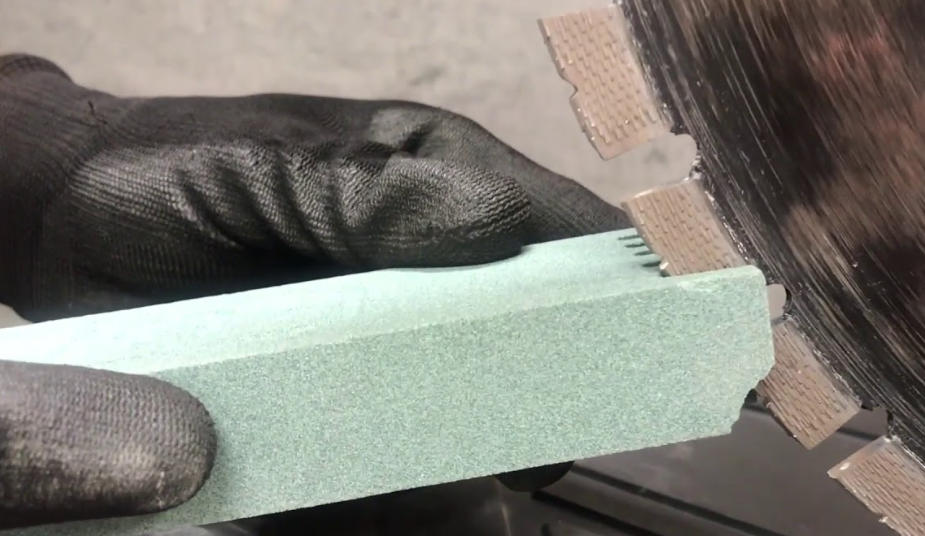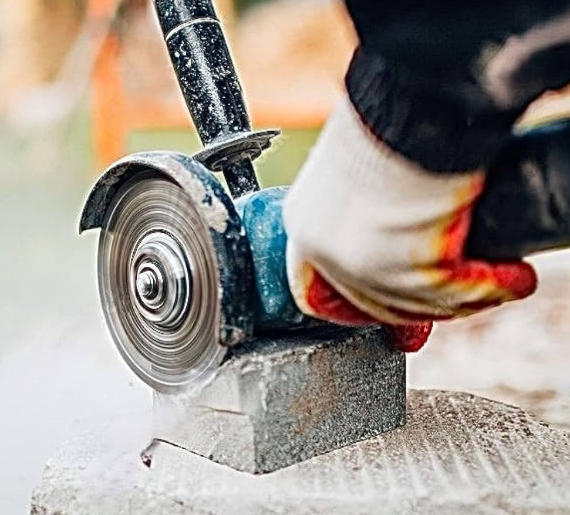Views: 0 Author: Site Editor Publish Time: 2025-10-11 Origin: Site
Ever noticed your diamond blade cutting slower, producing smoke, or leaving rough edges?
That doesn't always mean it's worn out — it might just be glazed. In that case, what you really need is blade dressing, sometimes called "opening" or "conditioning" the blade. This process restores your blade's cutting power by exposing new, sharp diamond particles and clearing away metal buildup from the bond.
Whether you're a construction professional cutting reinforced concrete or a DIY user working with tiles, learning how to properly dress your diamond blade will save you money and ensure consistently smooth, efficient cuts.

Unlike traditional steel blades that require sharpening to restore their edge, diamond blades don't get "sharpened" — they get "dressed."
During use, metal from the blade's bond can build up and cover the diamond particles. This prevents the diamonds from doing the actual cutting, leading to friction, heat, and poor performance.
Dressing removes this glazed layer, revealing new, active diamond edges. The result? Faster cuts, reduced overheating, and extended blade life.
Before you start, check whether your blade truly needs dressing — or if it's time for replacement.
•Cutting speed has noticeably slowed down.
•The blade produces excessive heat, sparks, or smoke during cutting.
•You need more pressure to push through the material.
•The cutting edge looks shiny or smooth — this "glazed" look means the bond has covered the diamonds.
•Cuts appear uneven or wobbly.
•Diamond segments are severely worn or level with the steel core.
•Segments are cracked, chipped, or missing.
•The steel core is warped or bent.
If the blade passes inspection but cuts sluggishly, proceed with dressing — not replacement.
To safely and effectively restore your blade, prepare the following tools:
•Diamond blade dressing stone (recommended method)
•Water or a water-cooling system (for wet saws)
•Personal protective gear: safety goggles, gloves, ear protection, and a dust mask
•The diamond blade you plan to restore
•Optional (for on-site use): a concrete block, brick, or silicon carbide wheel
Caution: Avoid using random materials like cement blocks or stones with metal inclusions — they can unevenly wear or damage the blade.
Follow these professional steps to safely and effectively bring your blade back to life.
Examine the rim or segments carefully. If they're cracked, missing, or nearly flush with the core, replacement is safer than dressing.
Place the dressing stone (also called a restoring block) on a stable, flat surface or secure it in your saw's cutting path.
Ensure the stone's width slightly overlaps the blade's rim for even contact.
If you're using a wet saw, confirm that the water-cooling system works properly.
The water cools down the tool more effectively, so there is also a smaller risk of overheating-related hazards.
Start the saw and slowly lower the blade into the stone.
Let the blade cut through the stone just like normal material — do not force it.
Move the blade back and forth several times, slightly adjusting the stone position after each pass to ensure uniform exposure.
Pro Tip: Listen to the sound — a "cleaner," more consistent tone usually indicates that dull metal has been removed and fresh diamonds are now cutting.
After about 3–10 passes, stop and inspect the rim. You should see new diamond particles sparkling across the segment's surface.
If the rim still looks glossy or dull, repeat the process a few more times.
When finished, rinse the blade with clean water (especially if using a wet saw).
Dry it completely and store it in a cool, dry place — ideally hung vertically to prevent warping.

•Safest and most precise option.
•Minimal wear on the blade.
•Recommended for professional shops and high-value blades.
•Common on construction sites.
•Make 10–20 shallow cuts (about 1–2 cm deep) into a clean concrete or brick block.
•Avoid rebar or metal inclusions.
This method effectively grinds away the metal bond, exposing new diamonds.
Warning: Cement blocks contain uneven aggregates that can cause irregular wear or even chip the diamond segments. Use only when no other option is available, and make very short, light passes.
•Always keep the cooling water running.
•Water helps prevent the blade from overheating, preserves the bond, and flushes away debris.
•Work in a well-ventilated area.
•Operate in short intervals to prevent overheating.
•Always wear a respirator or dust mask to avoid inhaling silica dust.
At SENMINE Diamond Products, we understand that performance and durability are everything.
Our diamond blades are engineered with optimized bond formulas and precision-graded diamonds — ensuring every particle contributes to efficient cutting and can be easily reactivated through proper dressing.
SENMINE blades not only cut faster and last longer but also recover performance more easily after dressing, reducing long-term replacement costs.
Explore our range of diamond blades designed for concrete, asphalt, tile, and stone — or contact our team for OEM and project-specific solutions.
• How often should you dress a diamond blade?
Dress the blade whenever you notice slower cutting speed or a glazed surface. For heavy use, every few weeks of operation is recommended.
• Should new diamond blades be dressed before use?
Generally, no — premium blades are pre-conditioned at the factory. However, if a new blade doesn't cut efficiently at first, a few light passes on a dressing stone can help activate the diamonds.
• Is dressing the same as sharpening?
Not exactly. Sharpening reshapes a metal edge, while dressing wears away the metal bond to reveal fresh diamond edges.
• What if the blade still won't cut after dressing?
This likely means the diamonds are completely worn down or the bond is too soft for your material. At that point, it's time to replace the blade.
• Can I use a silicon carbide wheel to dress a blade?
Yes — a silicon carbide wheel is an effective and controlled way to dress smaller blades used for tile or masonry cutting.
Dressing your diamond blade is a simple yet crucial maintenance task that can dramatically improve performance, save costs, and extend lifespan. By using the right materials and following safety protocols, you'll restore your blade's cutting efficiency and keep your projects running smoothly.
Experience the SENMINE Diamond difference — where precision meets endurance.
